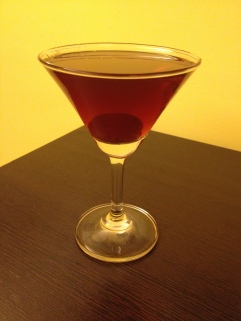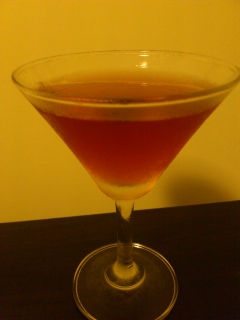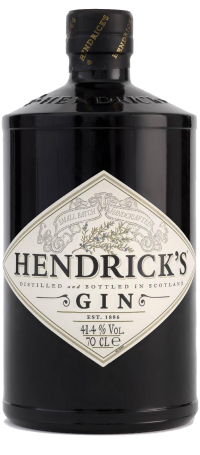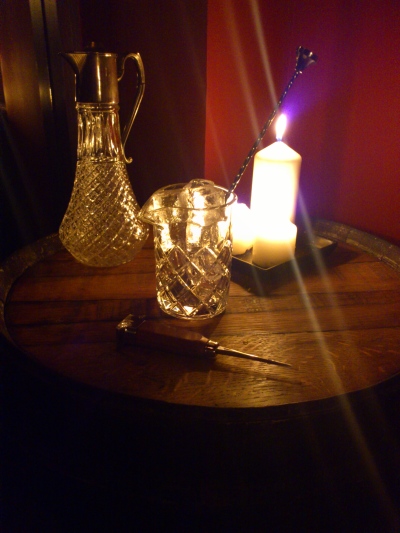Gin Tasting – Premium Gins
November 17, 2012
Saturday afternoon, my good friend is visiting the country, we have a scheduled power cut for five hours, and there’s torrential monsoon rain outside. What to do?
Cue my second round of gin tasting.
The first time I did something like this was several months ago and was much more basic. That time, I tried some very different products – Tanqueray, Plymouth, Old Tom and Genever.
This time around I set up three premium gins with three more regular brands (except that most bars would probably call the regular ones ‘premium’ and the others ‘super-premium’ or something).
My friend, my wife and I tried them all straight (after a little nosing), with a little water and in a gin and tonic (2 parts Schweppes tonic to 1 part gin with lemon wedge). Several weeks later, with a different friend, we did it again, but this time with a Martini (4:1 with Martini & Rossi and a dash of orange bitters + lemon twist) instead of gin and tonic. And we had a new gin, too. They weren’t blind tests. I had some knowledge of the brands (although I hadn’t read anything recently) but the other two were unencumbered by pre-formed expectations.
I have to say that none of us are expert tasters, and speaking for myself at least, I’m pretty awful at identifying smells and flavours. I can basically pick out sweet, sour, bitter, yucky and yummy.
I remember a long time ago Googling phrases like “What is the best brand of gin?” I now know that it’s not a good question. There are loads of quality brands and they all depend on your tastes, your mood, and what you’re mixing with. If you’re a gin fan, you wouldn’t rely on just one brand any more than a wine-lover would only drink one kind of wine.
That said, there were a few winners in our little testing.
Here are the seven we tried, and our thoughts on each. I have included some information from the makers or other sources about their botanicals used. That doesn’t mean we actually tasted all of them! Also, note the alcohol by volume. This differs in different markets – some countries or states tax spirits with higher ABV much higher, so these strengths are not usually sold. I prefer a good 47% or so strength for gin, especially for mixing, but it’s possible that the bottling we tasted is different from that available to you locally. All of these are available in Taipei, and I’ve noted where.
Plymouth Gin
Plymouth is the only gin in this taste-test that isn’t, strictly speaking, a ‘London Dry’ style of gin. It’s technically the surviving example of it’s very own category ‘Plymouth Gins’. That said, the basic taste profile is not that different. In fact, it’s closer to a ‘clean’ London Dry style than many gins with a more ambitious use of botanicals, so can make a good ‘neutral’ gin in cocktails.
ABV: 41.2%
Botanicals: juniper, angelica root, cardamom pods, coriander seeds, lemon peel, orange peel, orris root
Plymouth Gin is made in a 155-year-old copper pot still and is said to be distinguished by its ‘buttery’ base spirit and the naturally peaty granite-filtered water from the local Dartmoor Reservoir.
Tasting: We could taste light juniper, a little citrus and ‘lemon zestiness’. It tasted weaker and emptier others such as Tanqueray. Water didn’t improve it. It was much nicer in a gin and tonic, where we thought it was good. In the Martini the vermouth overpowered it.
Conclusions: Plymouth is nice; it just seemed weak and boring up against the other gins in our test. That said, it’s a popular mixing gin these days and I’ve come to appreciate it as such. It seems to go very well in Negronis and other cocktails which need a bit of orange citrus flavour. Orange bitters are a good match with Plymouth. Also when making earlier cocktails (ie pre-1890), Plymouth may be a better fit than London dries. It can go well in a drink where you want the gin to be a bit more subtle.
Availability in Taiwan: 9 City
Broker’s Gin
Although Broker’s is fairly new (1998) it is made to a 200-year-old recipe in an old distillery that is the same age. The botanicals used are all traditional gin botanicals, so it is a very traditional London Dry style gin. The first thing you notice about Broker’s is the bowler cap on the stem. Some hate it as a gimmick, but I think it’s cute. Just be sure to take it off if you’re using it often – it could easily make you drop the bottle.
ABV: 40%
Botanicals: juniper, coriander, orris, nutmeg, cassia bark, cinnamon, liquorice, orange peel, lemon peel, angelica root
Broker’s is made in a copper pot still with water from an underground spring at the distillery.
Tasting: We tasted strong juniper and the classic gin profile. We thought it was very similar to Tanqueray, but with perhaps a bit more citrus (and looking up the ingredients later seems to bear this out). Drinking neat, my wife thought it was a little lighter than Tanqueray, and my friend described it as a ‘gin hit in the mouth’. We thought it improved with the addition of water, but failed somewhat in a gin and tonic, lacking character. Tasting it on the second occasion, I thought it much better than the first time, and it tasted good in a Martini.
Conclusions: Broker’s suffered in our test as we thought Tanqueray was very similar, but better. That’s not surprising as both are very classic London Dry styles. That said, it’s still a very good gin, and you might like it if you feel that Tanqueray is a little too brash.
Availability in Taiwan: Carrefour, Breeze
Tanqueray is probably the most well-known of the gins in our taste-test, and perhaps also best epitomises the characteristics of a traditional London Dry style of gin. Its botanicals are part of a secret recipe, but are thought to be few – as little as four – with only three given by the distillers themselves. Started in London in the 1830s, Tanqueray is now produced in Scotland (much of the distillery was destroyed in the blitz).
ABV: 47.3%
Botanicals: juniper, coriander, angelica, and (widely assumed) liquorice
Tanqueray is now made in copper pot stills, including the 200-year-old ‘Old Tom’.
Tasting: We tasted strong juniper, a little spice and a hint of lemon. From the ‘nosing’ onwards, we all thought that Tanqueray was THE classic expression of gin. For me it just tastes ‘ginnier’ than all other gins. It was also described as ‘velvety’, full-bodied, dry tasting and tonic-like. The addition of water improved it. In a gin and tonic it was one of the very best, and also what we all thought of as the quintessential G’n’T. It was great as a Martini as well.
Conclusions: Tanqueray is my ‘go-to’ gin. I use it as the ‘default’ whenever trying a new gin cocktail. The 47% we get here stands up well to other ingredients, and it’s just ‘the classic’ London Dry profile. I know some think it’s too heavy on the juniper, but for me, more juniper just means more gin-like. Tanqueray was one of our top picks.
Availability in Taiwan: Carrefour and many bottle stores
Darnley’s is a very new gin dating back only to 2010. It is made by the Scotch-producing Wemyss family near Edinburgh, but is a fairly traditional, though light, London Dry style. The name is based on the view Mary Queen of Scots had of her future husband Lord Darnley, who was to father James VI of Scotland, who became James I of England, uniting Scotland and England (presumably in the same way that Darnley’s unites English and Scottish gin. I think it’s a stupid name.)
ABV: 40%
Botanicals: juniper, lemon peel, coriander seed, angelica root, elderflower and orris root
Tasting: We tasted weak juniper and a little citrus. Overall, we simply found it weaker and duller than most of the others. We thought the addition of water only brought out the flavours a little. We thought the gin and tonic rather boring and the Martini weak and watery.
Conclusion: I feel sorry for Darnley’s View; it seems like the real loser in our taste testing. But it’s certainly not a bad gin. I find the bottle alluring and am never disappointed when I take a sip. Maybe we missed it’s subtleties, as I’ve since found it to perform very well in Negronis, although I still doubt it’s ability to stand up well in most classic cocktails.
Availability in Taiwan: Megacity Mall City Super
Started ten year’s ago by an antiques entrepreneur, Martin Miller’s gin has a few interesting qualities. Firstly, the earthier botanicals are distilled separately from the citrus ones before being blended. A small amount of distilled cucumber is also added as a drying agent. After distillation, as portrayed on the (very nice looking) bottle, the gin is transported to Iceland to be blended with what they call the ‘purest water in the world’, which is apparently super oxygenated with a high surface tension which gives the gin a softer gentler taste.
ABV: 40%
Botanicals: juniper, coriander, angelica, lemon peel, orange peel, orris root, powdered licorice, nutmeg, cinnamon, and cassia bark
Martin Miller is distilled in a 100-year-old pot still called ‘Angela’.
Tasting: We tasted citrus and cucumber. We all had great first impressions of this gin. It could have been the excellent marketing and image of the bottle at work, or it could have ben truly living up to its image, but we all thought Martin Miller tasted exceptionally fresh with a smooth arctic coolness and not so much bite as more juniper-forward gins. We eventually identified with instant certainty the cucumber taste as one of the main reasons for this. Hendricks is known for cucumber, but I think you can taste it much more clearly in the Martin Miller, where it works very well. The addition of water improved the flavours and it was great in a gin and tonic (which I also later tried with a cucumber garnish which was also very nice). The vermouth seemed to accentuate these tastes making for an exceptional, albeit rather non-standard, expression of the Martini.
Conclusions: Undoubtedly a winner for all three us in this taste-testing, Martin Miller is an exceptional fresh and refreshing cool summer gin. That said, you’d have proceed with caution when mixing classic drinks, as its profile is so non-standard. But G’n’Ts and Martinis alone easily justify buying this gin. This could also be a good gin to lure vodka drinkers onto the true path.
Availability in Taiwan: 9 City, Breeze
Hendrick’s Gin, also little over ten years old, is made in Scotland. Its smooth marketing brands it as an unusual gin, and plays up its additives of rose and cucumber – spearheading the use of cucumber in place of lemon/lime in a G’n’T. Its distinctive opaque bottle adds to the image of a distinctive gin.
ABV: 41.5%
Botanicals: quite secret, but seem to include juniper, coriander, citrus, angelica, orris
Hendrick’s is distilled partly in a Bennet copper pot still, and partly in a rare Carter-head still where the more floral botanicals are added. These two distillates are then blended to make the final gin after the addition of cucumber and Bulgarian rose distillates.
Tasting: The scent of Hendricks was floral and perfumy, and the nice floral qualities came through when tasting it neat and with water. Juniper was in the background. We couldn’t taste the cucumber, but that might have been what made the Hendricks taste smoother than most of the other gins. Hendricks made one of the best gin and tonics in our test, but was middle of the bunch for Martinis.
Conclusions: We were very impressed with Hendrick’s in our first round of tasting (with gin and tonics) but a little less so in the second round (with Martinis). Hendrick’s seems to polarise a little, with many loving it and many finding it over-hyped. I tend to towards the former camp, but wouldn’t go the way of the Wall Street Journal and call it the best gin in the world. This is a good gin for cocktails where you are mixing with other floral ingredients.
Availability in Taiwan: 9 City and quite a few other bottle stores
Islay Scotch producers of the Bruichladdich distillery widen their portfolio with this aptly named gin containing 9 standard botanicals and a further 22 special botanicals all sourced from Islay itself. That’s 2-4 times as many botanicals as in most gins, which could make it either a gin of unmatched complexity or a complete mess of too many flavours.
ABV: 46%
Botanicals: juniper berries, angelica root, cassia bark, cinnamon bark, coriander seed, lemon peel, orange peel, liquorice root, orris root, apple mint birch leaves, bog myrtle leaves, chamomile, creeping thistle flowers, elderflower, gorse flowers, heather flowers, hawthorn flowers, juniper (prostrate) berries, Lady’s Bedstraw flowers, lemon balm, meadowsweet, peppermint leaves, mugwort leaves, red clover flowers, sweet cicely leaves, tansy, thyme leaves, water mint leaves, white clover, wood sage leaves
The Botanist is slow-distilled in a 60-year-old Lomond pot still called Old Betty. The standard botanicals are macerated first and the local botanicals are added via an infusion basket in the still. Islay spring water is used in the distillation and bottling.
Tasting: We tasted juniper and strong herbal flavours. We thought it dry and fairly bitter, but certainly interesting. I didn’t have this for our first round of tasting, so we didn’t try it in a side-by-side gin and tonic test. I made one later though and thought it fine. However, it really shone in the Martini. It was very herbal with a touch of cinnamon.
Conclusions: The Botanist was one of our favourites in the Martini – complex, distinctive and fascinating (though again quite non-standard). I wouldn’t use it in recipes calling for a normal London Dry, at least not expecting a normal result. This is another gin for appreciating on its own, in Martinis or with simple mixers. It’s not a refresher, but a gin for those who like a nice complex drink.
Availability in Taiwan: 9 City
Summary
The gin-tastings were a fun experience and a great way to get to know some gins and see the differences between them. Honestly, there were no winners, but going up against other heavy hitters left some otherwise excellent gins tasting boring and nondescript.
Plenty of gins that are available in Taipei were left out (I can only buy so many at once): Beefeater (a great traditional gin), Bombay Sapphire, Tanqueray No. 10, Greenall’s, Gordon’s (which I don’t care for), The London No.1 and more. I want to try them all sometime.
I expected it, but it’s very clear that there is no ‘best gin in the world’. It all depends on not only your own preferences, but what you’re mixing it with and what sort of mood you’re in.
Awards
Best gin for gin and tonic: Tanqueray, Martin Miller and (runner-up) Hendrick’s
Best gin for Martini: Tanqueray, Martin Miller and The Botanist
Best traditional gin: Tanqueray
Best atypical gin: Martin Miller (runners-up: Hendrick’s and The Botanist).
What should I be trying next? What’s your favourite gin?
Table of (Known and Assumed) Botanicals
| Tanqueray | Darnley’s | Hendrick’s | Plymouth | Broker’s | M Miller | Botanist | |
| juniper | √ | √ | √ | √ | √ | √ | √ |
| coriander | √ | √ | √ | √ | √ | √ | √ |
| angelica | √ | √ | √ | √ | √ | √ | √ |
| orris | √ | √ | √ | √ | √ | √ | |
| lemon | √ | √ | √ | √ | √ | √ | |
| orange | √ | √ | √ | √ | √ | ||
| liquorice | √ | √ | √ | ||||
| cassia | √ | √ | |||||
| cinnamon | √ | √ | |||||
| nutmeg | √ | ||||||
| elderflower | √ | √ | |||||
| cardamom | √ | √ | |||||
| others | √ |
Further Reading
First, We Drink Manhattans …
November 10, 2012
 The Manhattan! I was brought up believing that the Martini was the pinnacle of cocktail perfection. Now I know the truth. It’s the Manhattan.
The Manhattan! I was brought up believing that the Martini was the pinnacle of cocktail perfection. Now I know the truth. It’s the Manhattan.
True, the Martini is brilliant, and it’s amongst the handful of drinks which I’ll call ‘my favourites’ – all of which are tops in one way or another. But the Manhattan is tops in more ways than one.
It’s sophisticated yet somehow down-to-earth at the same time. It’s delicious. It’s satisfying. It has emotional resonance. It’s incredibly versatile, with endless possible variations. Add to all that the fact that it’s quick and easy to make (and can be readily ordered in any bar with generally good results). Yep, there may be many strong contenders, but the Manhattan IS my favourite cocktail.
People often say that a good cocktail is more than the sum of its parts, but that can be true in different ways. Some work together to bring out the best qualities of the spirits and mixers. Others create a whole new taste. I think the Manhattan does both. The vermouth does wonderful things to the whiskey, letting you taste the distinct qualities of the spirit you have chosen, and then there’s this extra taste – a Manhattanness – which is quite distinct form the tastes of the whiskey, vermouth, or bitters. The quality of the Manhattanness is what really makes a good one for me.
Oh, I’m not the only one to use this word ‘Manhattanness’. Just after writing this, I was flipping through David Wondrich’s ‘Imbibe’ for historical details, only to find him writing “The one-to-two “reverse” ratio here … (is) somewhat deficient in Manhattanness (to coin a word)”. Well, I guess I’m not the only one to hold that opinion.
What did I discover from Wondrich, on the historical front? Well, the Manhattan was probably invented in the 1870s, definitely in New York, and quite likely in the Manhattan club. It was one of the first drinks to use the newly popular vermouth in a stiffer ‘cocktail’. The Martini came later. The most common formulation was equal parts vermouth to whiskey, but that gradually gave way to the more contemporary two parts whiskey to one part vermouth formulation.
When I find a drink I like a lot, I like to drink it a lot. But I also don’t like to drink the same thing over and over again. Happily, the Manhattan lends itself superbly to endless variations. And it’s versatile as hell. Unlike some cocktails which are juggling acts of perfect balance, a Manhattan will absorb a lot of tinkering.
So this post is going to be a bit of an exploration of Manhattan variations.
Here’s my basic template:
2 oz whiskey (Bourbon or Rye)
1 oz sweet vermouth
2 dashes bitters
Stir well with plenty of ice and strain into a chilled martini or coupe glass. Garnish with a cherry or lemon twist.
Minor Variations: Garnish, ice and glass
Cherry and lemon twist are the usual garnishes. I like cherries but don’t always have either fresh or my homemade rum semi-preserved cherries in stock, and I don’t use ‘maraschino’ cherries. Lemon seems like a more delicate touch which goes well with other citrusy or citrus-hinted variations
When I’m drinking at home I always have a Manhattan straight-up – in a chilled martini/coupe without ice. But when I’m out, I usually have it in a rocks glass with ice. I like that too.
Proportions
My proportion is 2:1, and I like it, but a lot of recipes these days seem to call for 2:0.75.
In ‘Imbibe‘, David Wondrich says that for the first 20 years or so of the Manhattan, the 1:1 ratio was standard and another common variant was 1 part whiskey to 2 parts vermouth. I think the 1:1 is OK, but the ‘Reverse Manhattan’, although certainly a different drink, is better. The ‘modern’ Manhattan is clearly one thing, the ‘reverse’ another, but the ’50/50′ is not sure what it is.
Varying the Spirit
The big choice is Bourbon or Rye. Rye was the old favourite in the Northeast towards the end of the 19th century – the place and time the Manhattan was invented, so it can be seen as the traditionally ‘correct’ version, if you like. I like it a lot (with my Rittenhouse), but Bourbon is just as good really. My three brands – Woodford Reserve, Maker’s Mark and Knob Creek all make great Manhattans. When I have it with Jim Beam in a bar, it tastes great too. It’s a very forgiving drink!
 In my opinion, if it’s not made with Whiskey it’s not really a Manhattan – give it another name.
In my opinion, if it’s not made with Whiskey it’s not really a Manhattan – give it another name.
That said, I think a rum ‘Manhattan’ is great, as is a Genever ‘Manhattan’ (New Amsterdam).
A Rob Roy is a Manhattan with Scotch. Blended whiskey is the usual, but I think it tastes much better with a smokey single malt. The Bobby Burns is an excellent variation on the Rob Roy which sees Benedictine added to the mix.
I’ve also tried Manhattans with Jack Daniels (pretty good), Irish (alright) and Canadian (quite poor).
Bitters
Angostura is the traditional choice for the Manhattan and I like it, but my personal favourite is orange bitters (I use Angostura Orange, as it’s all I have).
 I also think Fees Brothers Whiskey-Barrel-Aged Bitters make a great Manhattan with Bourbon, adding a little spice which makes it closer to a Rye Manhattan (for those of us in Rye-deprived countries).
I also think Fees Brothers Whiskey-Barrel-Aged Bitters make a great Manhattan with Bourbon, adding a little spice which makes it closer to a Rye Manhattan (for those of us in Rye-deprived countries).
Peychaud’s is also excellent. I was surprised at how good Rhubarb Bitters were (Fees), and love the Fees Black Walnut bitters.
Grapefruit, peach, cranberry and chocolate were fine. Lemon, mint, cherry and celery weren’t.
My next idea: bitters combinations.
Switching out the vermouth
A popular tactic in creating Manhattan twists is to try fancy vermouths or substitute an aperitif wine or appropriate amaro (Italian bitter liqueur). Sadly, there’s not much of that around in Taipei. No Dolin, Noilly Pratt or Carpano Antica Vermouth. No Averna or Punt e Mes.
Perhaps the most well-known vermouth variation would be the ‘Perfect Manhattan’. In cocktail-speak, ‘perfect’ means equal parts sweet and dry vermouth. I don’t know if it’s just that I’m limited to Martini and Rossi Vermouth here, but I don’t really like this one. I even tried all-dry and that was worse.
 Bianco (White) Vermouth (discussed in this Jason Wilson column) is a great lesser known cousin of dry and sweet, but much different (the Martini and Rossi one is widely available). It makes a great light Manhattan variation which would be good for beginners. Wilson recommends leaving out the bitters with this one.
Bianco (White) Vermouth (discussed in this Jason Wilson column) is a great lesser known cousin of dry and sweet, but much different (the Martini and Rossi one is widely available). It makes a great light Manhattan variation which would be good for beginners. Wilson recommends leaving out the bitters with this one.
Lillet Blanc – a delicious ‘quinquina’ fortified wine with some similarities to vermouth – is also really good. It’s a nice light Manhattan with a definite taste of Manhattanness. (In Taipei, you can buy it at Sundy).
Dubonnet is also a ‘quinquina’ and makes a great Manhattan when substituted for vermouth.
Cynar is a bitter liqueur that I love, but is sadly unavailable in Taipei. It also makes a great Manhattan variation.
Adding Liqueurs
A common practice a hundred years ago was to add a dash or two of a sweet liqueur to a Manhattan (and many other cocktails). The ‘usual seasonings’ were curacao, absinthe and maraschino.
I’ve tried Marie Brizzard Orange Curacao and Grand Marnier (1 tsp) with orange bitters and an orange twist, and I think they both make a nice citrusy Manhattan.
 I’ve said before that I really don’t like absinthe, but (in very small doses) it can have a good effect on a cocktail – it smoothes it and gives the taste a little lasting power in the mouth. The same is true in the Manhattan – it went really nicely with my Woodford reserve. (I only use 1/4 tsp).
I’ve said before that I really don’t like absinthe, but (in very small doses) it can have a good effect on a cocktail – it smoothes it and gives the taste a little lasting power in the mouth. The same is true in the Manhattan – it went really nicely with my Woodford reserve. (I only use 1/4 tsp).
Maraschino (1/2 tsp) makes for a sharp Manhattan. I wasn’t too thrilled.
Other classic candidates would be Benedictine and Chartreuse, but I haven’t really tried them.
The modern ‘splash a bit in everything’ liqueur is St Germain Elderflower, and a teaspoon or two does make for a very fine Manhattan.
With any of these, you might want to tone down the vermouth a little to compensate for the added sweetness.
More Complicated Variations
There are loads and loads of more involved Manhattan variations around. Here are the ones I’ve tried.
Little Italy
2 oz rye
1/2 oz Cynar
3/4 oz sweet vermouth
cherry garnish
This one is truly excellent. I love Cynar. Here it partly substitutes for the vermouth and for the bitters.
Dandy
1 1/2 oz rye
1 1/2 oz Dubonnet
1 dash Angostura Bitters
3 dashes orange bitters
3 dashes Cointreau
1 piece lemon peel
1 piece orange peel
Shake and strain.
It’s a while since I tried this one – when I was doing my Dubonnet drinks – but according to my notes it was very good; one of the best Dubonnet cocktails, in fact.
1 1/2 oz Bourbon
3/4 oz Tuaca
2 dashes Peychaud’s Bitters
cherry garnish
Tuaca is a vanilla-based liqueur (unavailable in Taiwan), so having this stand in for vermouth is stretching it a bit, and, in fact, I found this one a bit unbalanced. It was interestingly ‘bouncy’ though. ‘Bouncy’ is what I call a drink in which you taste one element and then one quite different one and bounce back and forth between the two. In a good drink you should end up right in the middle. This one didn’t really.
Rochester Cocktail
2 oz rye
1 oz Dubonnet
1/2 oz Licor 43
1/4 oz absinthe
2 dashes Angostura Bitters
lemon twist garnish
Licor 43 is another vanilla liqueur, so I substituted Tuaca, and it worked much better in this one, which turned out very nice. The absinthe worked very well too, and it had definite Manhattanness.
Arts District
2 oz rye
1/2 oz Cynar
1/4 oz Benedictine
grapefruit peel garnish
I thought this one was nice, but with this recipe probably had too much Benedictine and not enough Cynar.
 I have recipes for quite a few more Manhattan variations, but many call for ingredients I don’t have, and I’ve run out of rye again (no rye in Taiwan!), but when you think of the different elements that can be varied, it’s quite easy to ad-lib your own. Just think of what variations go with each other and what spirit to use with that.
I have recipes for quite a few more Manhattan variations, but many call for ingredients I don’t have, and I’ve run out of rye again (no rye in Taiwan!), but when you think of the different elements that can be varied, it’s quite easy to ad-lib your own. Just think of what variations go with each other and what spirit to use with that.
What are your favourite Manhattan variations?
Next week: … And Then We Drink Some Gin.











